The Brain and Nervous System
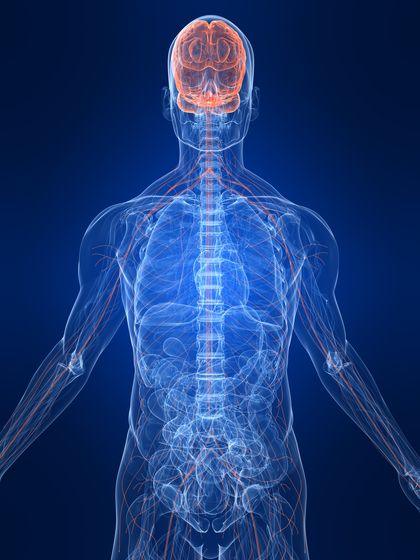
The nervous system is the complex body system that most directly determines and organizes a person's reactions to the world in which he or she lives. It includes the central nervous system, which is made up of the brain and spinal cord, and the peripheral (per-IF-fer-ul) nervous system, which includes all of the nerves and other nervous structures in the rest of the body.
KEYWORDS
for searching the Internet and other reference sources
Central nervous system
Neurology
Neurotransmitters
Peripheral nervous system
Orchestrating Everyday Life
If life is a symphony of activities—both voluntary activities, such as walking, talking, reading, or going to class, and involuntary activities, such as breathing, digesting food, pumping blood, and perspiring—then the nervous system is the orchestra that makes it all happen. This system controls all of the adjustments people need to make in response to their environment, from basic functions such as sweating on a hot day to more sophisticated tasks such as concentrating attention during a particularly difficult lecture. Without the nervous system and its conductor, the brain, people would not experience joy at seeing an old friend or automatically pull their hand away from a hot stove.
Injuries and diseases that affect the nervous system not only de, monstrate how important the system is to everyday life but also show how the brain really determines who a person is as a human being. The actor Christopher Reeve, most famous for his movie role as Superman in the 1970s and 1980s, was thrown from his horse and his spinal cord just below his brain was crushed. Because of his spinal cord injury, he cannot move or breathe on his own, and machines now do some of his bodily functions for him. But because his brain was not injured, Reeve can talk, experience emotions, and plan and make decisions (for example, after the accident he directed a movie). Though being physically active is no longer a part of his identity, Reeve can still enjoy his roles as husband, father, friend, and filmmaker. Since his injury he has participated in acting and directing projects, and has taken on a new role as spokesperson and advocate for spinal cord injury research. A book he wrote about his experiences since his injury is aptly titled Still Me.
Injuries and diseases of the brain are often devastating in a different way than are spinal cord injuries. They may affect movement, but they
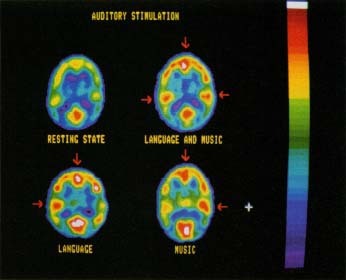
Because people tend to think of personalities and character traits as fixed, it is strange to realize that injury or disease could really change who a person is. While people can receive a new kidney, lung, or heart to replace a diseased one, they cannot receive a new brain or spinal cord: currently, these structures are irreplaceable.
Many Systems in One
The nervous system is a network of fibers that starts in the brain and spinal cord and branches out to the rest of the body, with each branch getting progressively smaller. The nervous system can be thought of as a pine tree, with the brain and spinal cord forming the trunk and the nerve fibers forming the branches. In the human body, the trunk is called the central nervous system, or CNS, and the branches are known as the peripheral nervous system.
Central nervous system
The CNS includes the brain, which is encased in the skull, and the spinal cord, which is a long tube that extends
150 Years Ago: The Famous Case of Phineas Gage
In 1848, a Vermont railway foreman named Phineas Gage was helping to expand the nation's growing network of railway tracks. His job was to make way for new track by blowing up any obstacles in its path, such as rock formations. Gage would use a long rod to push the dynamite down into a hole. One day, the dynamite exploded too soon, and the iron rod was actually driven into the left front side of his skull. After a brief period of unconsciousness, Gage recovered from the injury, and the wound around the rod healed. He could still walk, talk, and move as he did before.
However, the people around Gage began to notice some major changes in his personality. Before the explosion, Gage had been friendly and hardworking, but after the accident he became indecisive, uncaring, and stubborn. Gage was just not the same person he had been. Eventually he left his railway job to take part in what were then called freak shows at fairs.
Gage's experience provided an important clue about how the brain works. Clearly the prefrontal cortex (the front part of the brain where the rod was imbedded) was not important for life functions such as breathing, body temperature control, sensory perception, or movement. Instead, it appeared to be associated with the individual's personality. Later studies have confirmed that the front portion of the cortex really is where a person's character lies. Damage or injury to this area has the potential to change the qualities that people consider so essential to who they are.
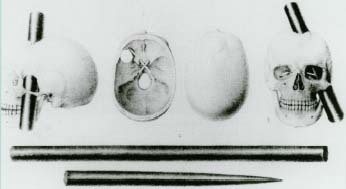

out of the brain and down through the spine, or backbone. Higher nervous system functions, including movement, perception, memory, learning, emotion, and consciousness, are carried out within the brain. The spinal cord has other roles. It controls simple reflexes like the knee-jerk that happens when a doctor taps just below the knee (a familiar part of a routine physical examination) and rhythmic movements such as walking or scratching. It also relays sensory information such as touch, temperature, and pressure from the various parts of the body into the brain. A crossover effect occurs after the information is received: information from the right knee goes up the spinal cord on the opposite side from which it was received, eventually reaching the brain on the left side. The spinal cord also carries signals that control movement (motor signals) out of the brain to the rest of the body. The left side of the brain sends signals to the right side of the body, and vice versa.
Peripheral nervous System
The nerve cells and other nervous structures in the body outside of the CNS are known as the peripheral nervous system (peripheral means outside). These nerves receive information from body tissues and the outside world and pass it along to the brain and spinal cord. These nerves also carry the signals from the CNS to make body parts move or function. The peripheral system can be divided into three parts:
- The voluntary motor nerves control the muscles of the arms and legs, the head, and other parts of the body. When a person swings a golf club, swats a fly, climbs a flight of steps, or does some other action on purpose, this system comes into play.
- The sensory nerves carry sensory information such as touch, temperature, pressure, and position from the skin and other body parts to the brain.
- The autonomic (aw-to-NOM-ik), or involuntary, system regulates the internal organs, including the heart, digestive tract, lungs, bladder, blood vessels, and glands. These functions happen automatically without a person controlling them. There are two further divisions of the autonomic nervous system: the sympathetic and the parasympathetic systems.
- The sympathetic nervous system, also called the "fight or flight" system, prepares people to deal with frightening or stressful situations, such as a difficult exam, a job interview, or a hostile confrontation. Just about everyone has had the experience of a racing heartbeat and sweaty palms just before a big presentation or a big exam. The sympathetic nervous system primes the body for action by speeding up the heart rate and breathing rate, which sends more oxygen-rich blood to the muscles. The pupils of the eyes dilate to allow more light into the eye, and at the same time, digestive system activity slows down.
- Parasympathetic nervous system activity, for the most part, causes the body to relax: heart rate and blood pressure drop, the digestive system becomes more active, and the pupils of the eyes constrict. Sometimes called the rest and digest system, it comes into play for most people after finishing Thanksgiving dinner!
Regeneration
While the peripheral and central nervous systems work together, they differ in one very important way: the peripheral nerves can regenerate, or grow back, if they are damaged, but damage to the brain or spinal cord is permanent. For example, if someone loses a finger or limb and it is reattached promptly, the severed nerves will usually grow back over time. However, the paralysis that often accompanies spinal cord injuries, as in the case of Christopher Reeve, is permanent. Brain damage is permanent, too, although other parts of the brain sometimes can take over the function of the damaged areas. Doctors have observed this phenomenon in people who are recovering from a stroke, which is usually the result of a blockage in one of the blood vessels that feeds the brain.
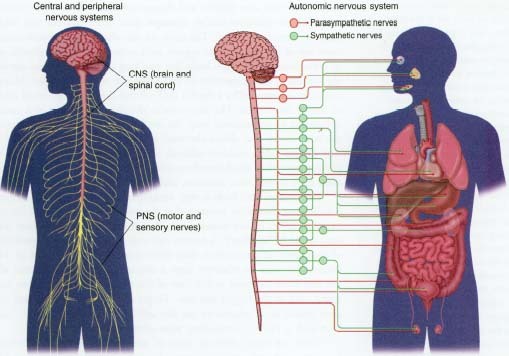
The brain tissue that went without oxygen-rich blood is damaged permanently, but other areas sometimes take over its functions (such as movement or speech). Research on spinal cord injuries and other central nervous system disorders continues, and many scientists believe that one day they may find ways to reverse damage that now seems permanent.
What Are the Basic Building Blocks
of the Nervous System?
"You're getting on my nerves." "He has some nerve." "I'm all nervous about the test." The word nerve is part of everyday language, but few people think about its literal meaning. The nervous system is made up of nerves, which in turn are made up of smaller units called neurons (NUR-ons), or nerve cells. Despite the important difference between the CNS and the peripheral nervous system in their ability to regenerate, all the parts of the nervous system are made up of these same basic building blocks. Understanding them is the key to understanding how the nervous system as a whole works.
A neuron is a single cell with three main parts: the central cell body, the dendrites, and the axon. Each neuron typically has many dendrites but just one axon. Dendrites look like tree branches that extend from the cell body: they are relatively thick as they emerge from the cell, but they branch out into thinner and thinner structures as they get farther away. These structures receive messages from other neurons and then transmit them into the cell. The axon, on the other hand, transmits messages out of the cell to other organs, such as the muscles and glands, or to other neurons. An axon looks like one long strand that comes out of the cell body, and sometimes its end forks into several branches. Many axons are surrounded by a myelin (MY-uh-lin) sheath, a segmented tube of mostly fatty tissue. The axon-myelin sheath system works in a manner similar to an insulated wire: the insulation (myelin sheath) protects the wire (axon) and allows electrical message pulses to flow smoothly. The disease called multiple sclerosis (skluh-RO-sis) wears away at this protective myelin, which interferes with nerve function and causes symptoms such as weakness, dizziness, and loss of muscle control.
The neuron's cell body is tiny, ranging from about 1/200 to 1/10 of a millimeter. Scientists estimate that the human nervous system has as many as 1,000 billion neurons (which is more neurons than there are stars in the Milky Way!). A neuron can make thousands, even hundreds of thousands, of connections with other neurons. The only part of the neuron that may be relatively large is the axon. Some axons extend all the way from the head to the base of the spinal cord, others from the spinal cord to the fingers and toes. To get a sense of how large such an axon would be in relation to the tiny cell body, imagine a helium balloon with a 14- or 15-mile-long piece of string attached.
Learning a New
Language: The Sooner
the Better
A daughter is born to an American fa-ther, who speaks only English, and a Spanish mother, who speaks both Spanish and English. If these parents choose to speak both languages to their new daughter, she will likely become fluent in both. While logic might suggest that this would be confusing to the baby, she is actually at the perfect time in her life for learning two languages. If she is raised hearing and speaking only English and waits until high school to take Spanish, learning the new language will be much harder. Why?
As humans get older (and especially after they reach puberty, or sexual maturity), they lose their ability to learn a new language perfectly. Babies and young children are better able to take in and imitate a wide range of sounds. Later in life, if they have grown accustomed to hearing the sounds of just one language, then mastering a second language be-comes much harder. Psychologists be-lieve that the synapses and neuronal connections in the brain's language area develop according to the individual's ex-perience. Hearing more than one lan-guage from a young age builds the cir-cuits that are needed for each language. In other words, this experience shapes the brain in very specific ways.
In his book Creating Mind: How the Brain Works, Harvard professor John Dowling relates the experience of living in Japan for seven months with his five-year-old daughter. Within four months, his daughter was able to speak Japanese fluently, and she did so even better than his wife who had been studying the language for three full years. Dowling saw this as an example of the young brain's plasticity: his daughter's brain had a flexibility that his wife's did not.
There are many different types of neurons that perform different functions within the nervous system. Sensory neurons, for instance, take
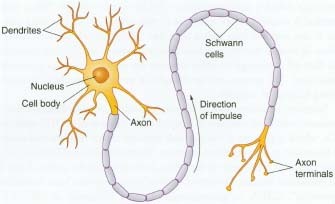
Within the brain and nervous system, neurons cluster together to do their jobs. Ganglia (GANG-lee-uh) are groups of nerves cells that function together, and ganglia are usually found outside the central nervous system. Basically, they are centralized control centers that make sense of messages from different receptor cells and coordinate the activity of different muscle groups. Nuclei (NEW-klee-eye) are groups of nerve cells in the brain and spinal cord that have the same function, such as supporting the sense of hearing or smell.
How Do Neurons Communicate?
The nervous system works only because the neurons are constantly communicating with each other. How does this process happen? Even though it is a complex process to describe, it happens more quickly than the blink of an eye. To simplify things, consider just two neurons: one that is sending a message and the other that is receiving it.
The sending neuron and the receiving neuron are separated by a small space called a synapse (SIN-aps). The end of the sending neuron's axon has small sacs called vesicles (VES-sick-ulz) that store a special chemical messenger called a neurotransmitter (NUR-o-tranz-mit-er). When this chemical is released, it can have one of two effects on the receiving neuron: it can excite it into action or it can inhibit (block or slow down) action. A neuron receiving certain signals produces an electrical impulse and fires off a message to other neurons by releasing its own chemical transmitter. The process can be thought of as an endless chain reaction among billions of neurons.
Scientists have been able to identify a hundred or more different neurotransmitters. One example is acetylcholine (uh-seh-til-KOHL-een), or ACh, which is released at the junction between motor neurons and muscle fibers and makes the fibers contract. Serotonin (sir-uh-TON-in), another chemical messenger in the brain, is involved in the states of sleep and emotional arousal. Decreased levels of serotonin have been linked to depression * . GABA, or gamma-amino butyric (GA-muh uh-MEEN-o byoo-TEER-ik) acid, is a transmitter that inhibits other neurons rather than exciting them into action. (For an illustration of neurotransmission, see "Medications.")
Some drugs that target neurotransmitters can be beneficial in treating certain diseases and conditions. For example, a substance called L-DOPA, which enhances the levels of the transmitter called dopamine * in the brain, has been found to help people with Parkinson's disease by improving symptoms such as tremors and difficulty controlling movements. In people who have this disease, the dopamine-releasing neurons in the brain are not functioning as they should be, and this problem tends to get worse over time. Many people with depression have been helped by medications that increase the availability of neurotransmitters such as norepinephrine * and serotonin in the brain.
* depression (de-PRESH-un) is a mental state characterized by feelings of sadness, despair, and discouragement.
* dopamine (DOE-puh-meen) is a neurotransmitter in the brain that is involved in the brain structures that control motor activity (movement).
* norepinephrine (nor-eh-pin-EH-frin) is a neurotransmitter that is involved in arousal systems in the brain and in the action of the sympathetic nerves on blood vessels and internal organs.
Command Central: The Brain
If the nervous system as a whole governs the body's voluntary and involuntary functions, then the brain is the president of that government. This cream-colored, wrinkled organ weighs only about three pounds and has the consistency of gelatin in a mold. The main part of the brain, called the cerebrum (suh-REE-brum), has two hemispheres, or halves, that sit on top of a thick stalk, known as the brain stem, that attaches it to the spinal cord. The very top crinkled layer is called the cerebral cortex (suh-REE-brul KOR-teks): this is where higher mental functions such as thinking, reasoning, and emotion take place. The human cerebral cortex is much more developed that that of other vertebrates (animals with a spinal column), and overall the human brain has more nerve cells than animal brains do. Behind and beneath the cortex is a small, cauliflower-shaped part of the brain called the cerebellum (sir-uh-BELL-um), which literally means little brain. The cerebellum is responsible for coordinating motor activities, from walking to juggling. Some scientists believe that the cerebellum is like a motor computer that controls activities in-volving balance and motor skill so that the rest of the brain is free to focus on conscious activities.
200 Years Ago: Mapping the Mind
In the early 1800s, the "science" of phrenology (freh-NOL-uh-jee) was introduced by an Austrian doctor named Franz Gall. Gall theorized that studying the skull surfaces of people who had died would allow him to map their personalities onto the brain. He believed that different areas of the brain were responsible for different traits and that certain bumps or depressions on the skull would correlate with the person's characteristics. Based on these studies, Gall created a map of the mind and started practicing what came to be known as phrenology on living people.
Gall would use a special hat to map a total of 32 qualities, including attachment and friendship, cruelty, cleverness, memory, sense of humor, sense of words, and sense of color. When the hat was placed on the person's head, any bumps on the surface of the skull would push certain pins upward through a piece of paper. The pattern on the paper was viewed as a readout of an individual's character traits.
While this may sound unbelievable to twenty-first century psychologists, phrenology actually became quite popular in the nineteenth century. In addition to paying for phrenology readings, people would buy books and pamphlets on the subject. Some would even get a small personalized model of their head for the tip of their walking canes! In those days, phrenology seemed like a scientific way of understanding how personality is determined. In the twenty-first century, though, it sounds more like a horoscope or palm reading: it may be entertaining, but it has no basis in scientific fact.
Phrenology began to fall out of favor in the mid-i800s, when other discoveries refuted Dr. Gall's theory. In 1861, the French anthropologist Paul Broca examined a man who was unable to speak, except for repeating the word "tan." After the man died, Broca examined his brain and found that the damaged area was completely different from that predicted by phrenology. While phrenology suggested that language was controlled by the lower part of the left eye socket, Broca found that a small region toward the front of the left side of the brain was the true language center.
Nevertheless, Dr. Gall was on the right track in thinking that different regions of the brain are responsible for different functions.
Like the other structures of the nervous system, the brain is made up of neurons that receive, process, and transmit information across synapses through chemical means. It is also composed of supporting cells called glia (GLEE-uh), which provide a supporting structure for the neurons.
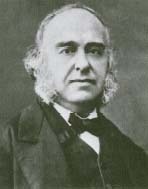
Brain cells cannot divide and replace themselves like other cells in the body can. The brain of a human newborn contains as many neurons as it will ever have; in fact, people lose as many as 200,000 brain cells per day as they age. By the time people enter their 60s, 70s, 80s, or 90s, they may have lost anywhere from 5 to 20 percent of their original brain tissue. This helps explain why some older people (though certainly not all!) slow down mentally or have trouble remembering. Just as people need to keep their bodies in shape, they need to keep their brains in shape by taking on new challenges and learning new things. Also, people should wear that bicycle helmet; if brain cells are lost at any age because of injury or disease, they cannot replaced.
The brain has many different regions that are marked by textural or color differences or that are separated by fluid-filled areas. Throughout the twentieth century, researchers made major advances in understanding how different areas of the brain are involved in the control of activities such as movement, hearing, speech, and emotions. Scientists have also learned that these specific areas cannot carry out these functions alone. Instead, it is now known that different areas in the brain have to work together to accomplish all the complex activities that are part of human thought and consciousness. So the brain really does function like an orchestra!
How Does the Brain Develop?
As already noted, the brain's neurons do not divide to make new cells that can replace those that are aging or damaged, as happens with most
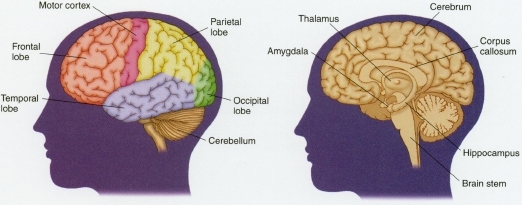
The developing human brain looks a lot like the developing brains of other animals, such as rats and rabbits. However, this changes at about seven months of pregnancy when the cerebral cortex of the fetus gets larger and starts to develop the many folds that allow more brain matter to fit inside the skull and gives humans more brain power. Over the next two months, the neurons continue to mature, and their axons and dendrites form increasingly complex branches and interconnections with other nerve cells. By nine months (at or near birth), babies have most of the neurons in their brain that they will ever have.
Left Brain/Right Brain:
Do People Really Have
Two Brains?
It has long been believed that the right hemisphere of the cerebral cortex controls artistic creativity and the use of language and the left side controls analytical thinking and working with numbers. While this is much too simple a division, the right and left hemispheres do appear generally to have different functions. In most left-handed people, the right cortex appears to be dominant, whereas the reverse is true in right-handed people.
Researchers have found that in most people, whether left-handed or right-handed, the areas that control language are located in the left hemisphere. Broca's area, which is located in the frontal lobe (the front of the brain), is concerned mainly with the production of speech. Wernicke's area is located in the temporal lobe (the temporal lobes are located on the two sides of the head) and is concerned with the comprehension of speech and with reading and writing. Both of these areas are named for the scientists who first identified them.
The most compelling evidence that the right and left hemispheres of the human brain function differently has come from split-brain studies, which are studies of people with severe epilepsy (EP-i-lep-see), whose corpus callosum (KOR-pus kuh-LO-sum; the bridge between the two brain halves) was surgically cut to help control seizures. Epilepsy is a condition of the nervous system characterized by recurrent seizures that temporarily affect a person's awareness, movements, or sensations. When these people hold objects in their right hands or look at words or objects flashed at their right eye, they can quickly name the object or describe what they are seeing. That is because the information is sent to the left side of the brain where the language areas are (via the brain's crossover effect). However, they cannot say what they are touching or seeing if forced to use their left hand or eye. This information is sent to the right hemisphere, but it has no way to cross the message over to the language areas in the left side. Researchers have also shown that in healthy people, word recognition happens just a bit faster when a word or object is flashed at the right eye, again because it goes right to where the language areas are in the left side. Of course, if the language areas are in the right side, as is true for many left-handed people, the reverse happens.
Although the number of neurons in the brain does not increase after birth, the connections between the neurons continue to develop, especially during the first years of life. Axons keep growing out from
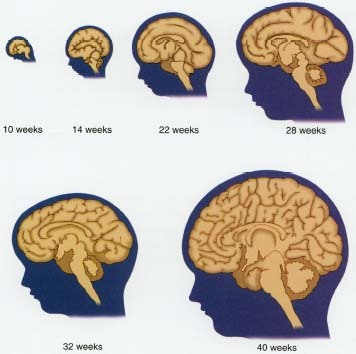
There are a number of conditions that can result in mental retardation * by interfering with the normal development of the brain before birth, during birth, or even during childhood. For example, genetic * abnormalities can cause disorders that affect a child's development or metabolism * , which in turn can cause problems in the brain. Sometimes, for reasons that are not always understood, the brain is damaged or just does not develop normally before birth, as occurs in the condition called cerebral palsy. If the mother drinks alcohol or does not take in sufficient vitamins or other nutrients in her diet during the pregnancy, brain and spinal cord development can also be affected.
* mental retardation is a condition in which people have below average intelligence that limits their ability to function normally.
* genetic refers to characteristics that are passed from parent to child by genes.
* metabolism (meh-TAB-o-liz-um) is the process in the body that converts foods into the energy necessary for body functions.
Resources
Books
Brynie, Faith. 101 Questions Your Brain Has Asked About Itself but Couldn't Answer… Until Now. Brookfield, CT: The Millbrook Press, 1998.
Conlan, Roberta, ed. States of Mind: New Discoveries About How Our Brains Make Us Who We Are. New York: John Wiley and Sons, 2001.
Ramachandran, V. S., and Sandra Blakeslee. Phantoms in the Brain: Probing the Mysteries of the Human Mind. New York: HarperCollins, 1999.
Organization
Neuroscience for Kids is an extensive and entertaining website
maintained by Research Associate Professor Eric Chudler at the
University of Washington, Seattle. It features easy-to-understand
information on a range of topics related to the brain and nervous
system.
http://faculty.washington.edu/chudler/neurok.html
Though, I MAY sleep, seldom do I wake refreshed. As due to my constant headache, my body continues to struggle, through the night, with the pain. I have been tested, for sleep disorders, and nothing significent has been found.
I am on Effexor XR (300mg daily) and a blood pressure medicine. These medications are not something new for me.
Could you PLEASE suggest a Hospital, I need to contact, that would admit me, and keep me for an extended stay and perform tests, while monitoring and observing me 24 hours, per day?
Thank you, for your time and consideration.
Sincerely,
Perry Pruitt